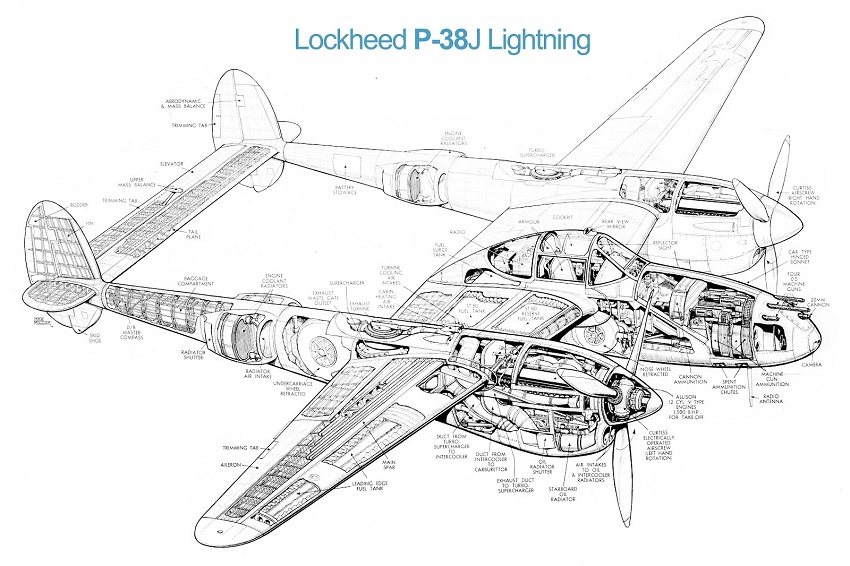Aircraft > Multi-Engine Piston > Lockheed > N38LL: Lockheed Lightning
N38LL: Lockheed Lightning
Last Updated
Dec. 21, 2021
Details
Registration #
N38LL
Status
Off Market
Year
1975
Make
Lockheed
Model
Lightning
Serial Number
42-104088
TTAF
0
Location
Breckenridge, Texas, United States
Listings
Site
Price
Status
Updated
Description
LOCKHEED P-38J LIGHTNING PROJECT NICKNAME: SCATTERBRAIN KID II, A rare opportunity to purchase one of Americas most interesting fighter aircraft. Less than 10 P-38s remain in flying condition today.
Avionics
Lockheed delivered some 9,925 P-38s. The J series saw the intercoolers moved from the wing leading edges to just below the propeller shafts leading to the distinctive chin in the engine cowlings and improved performance from the Allison engines. The -10 production block came with a flat bullet-proof windshield. The aircraft is presumably from the -15 block where a new electrical system and new turbo-supercharger governors were fitted. Fourteen hundred P-38J-15’s were built from December 1943 to May 1944. This P-38J-15-LO was accepted at Lockheed in Burbank, California on 8 January 1944. It was assembled at Plant A-1 from components built by some 22 sub-contractors across the country (including Consolidated-Vultee in Nashville that built the wing center-section). After final assembly, it would have been towed through city streets at night to the Lockheed Air Terminal for delivery. The Air Transport Command (ATC) took over and moved the aircraft to the Dallas modification center via Long Beach and El Paso with arrival on 10 January 1944. This center took on the work of customizing aircraft while allowing Lockheed’s mechanized production line to work more efficiently. In this case, it appears that fuel tanks were installed in the leading edges of the wings (this area had been left vacant by the intercooler move). Reinforcing strips would have been added to the wings in this area to prevent the skin from ripping during high-G maneuvers given the added weight of the fuel tanks. In addition, a black cross was painted on the port side below the cockpit to alert the ground crew to the existence of the tanks. This aircraft was destined for the 12th Air Force in Europe, so the ATC shuttled it to Newark via Atlanta leaving on 18 January 1944 and arriving on 22 January 1944. Newark was a major staging point for trans-Atlantic flights and this P-38 departed on 29 January 1944. The 12th Air Force received it the next day and then appears to have transferred it to the 8th Air Force with receipt on 29 March 1944. It finally ended up with the 370th Fighter Group (FG) in the 9th Air Force on 19 April 1944 just as air preparations for the D-Day landings were gearing up. The 370th FG had its genesis in a desire by pilots at the USAAF proving grounds to get into combat. It was activated on 1 July 1943 and trained with P-47s for ground attack missions. The unit sailed for Europe in the Mauretania on 31 January 1944; landing at Liverpool and being assigned to the USAAF station 467 at Aldermaston. It was here that the unit was abruptly switched to P-38s. After a quick stay at Aldermaston, the 370th FG shifted to RAF Andover on 29 February 1944 where training in P-38s began in earnest. 42-104088 was received on 19 April 1944 at a time when pre-invasion practice missions were being flown over the Devon coastline. On 23 April 1944, famed Lockheed test pilot Tony LeVier buzzed the field as part of an effort to boost confidence in the P-38. This was important, because much of March was lost due to the grounding of all P-38s while engine changes and modifications were made. Historical records often do not list aircraft serial numbers by unit. In the case of 42-104088, the serial number was located on the 1 August 1944 Combined Loss Listing which placed the aircraft with the 370th FG. The 370th FG was comprised of the 401st, 402nd, and 485th Fighter Squadrons (FS). The serial number was found in a photo of the 485th FS assignment board. Next to the serial number in the photo is the abbreviation “RAD” for the pilot—Frank B. Radcliff. The 485th FS was formed on 25 July 1943 under Major Seth McKee and trained throughout New England before sailing to England with the 370th FG. The first combat mission, a fighter sweep over France, was flown on 1 May 1944. Black and white invasion stripes were applied on 4 June 1944 and the 370th FG P-38s were the first aircraft on station covering the invasion fleet on 5 June 1944. The 370th FG flew bomber escort, armed reconnaissance, fighter sweep, continuous cover, and dive bomber missions in support of the landings, the drive up the Cherbourg Peninsula, and the fighting to break-out of Normandy (including Operation Cobra at the end of July). On 27 July 1944, the 485th FS shifted to an advance field in Normandy at Deux Jumeaux. Frank Radcliff was one of the original pilots and flew some 80 missions and earning the Distinguished Flying Cross before transferring out of the unit in November 1944. One of his letters home describes the loss of the 42-104088: Bad news! I lost Miss Dynamite (his name for 42-104088). I have never put a scratch on her but three other fellows have. One boy took her out + just as he shot down an enemy plane three of them shot him. He managed to get the ship back with 19 cannon holes in her. She was in repair about two weeks then another boy got her shot up. It only took two days that time. Day before yesterday (1 August
Airframe
The package consists of a damaged aircraft, many extra parts and is packed for shipping wooden crates and on pallets. The Center section of the aircraft and one tail boom have been rebuilt by West Pac in Colorado to an extremely high standard.
